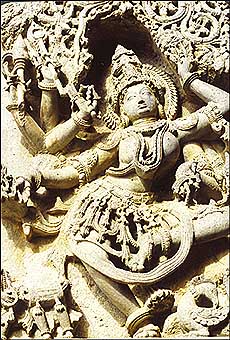
by Kuldip Dhiman
HEAVENLY guardian angels welcome you as you enter the ornate doors of the temple; a bevy of voluptuous apsaras and dancing girls tempt you with their sensual curves; scenes illustrating the two epics are there to entertain and inform; the gaze of the principal deity overwhelms you as you enter the inner sanctum. These are the splendours of Belur and Halebid where the sculptors of the bygone age seem to have stretched the art of sculpture to its very limits.
They may not be as well known as the Khajuraho temples, but the temples built by the Hoysala Dynasty between AD 1050 and 1300 in Karnataka epitomise the artistic splendour of their time. The singular feature of these temples is the obvious shit of emphasis from architecture to sculpture. Granite appears to have become modelling clay in the hands of the sculptors of the magnificent statues that are on display. The first of the Hoysala temples, the Chennakesava temple of Belur and the Hoysalesvar temple of Halebid, are the very paradigms of Hoysala art. The construction of both these temples began in AD 1117.
The 38 splendidly carved bracket figures of the Chennakesava temple illustrate the concept of the ideal woman according to the social mores of the 12th century. These highly ornamented curvaceous and rather plump beauties, called Mandanikas, are clearly the pieces de resistance that the temple has to offer. This, however, does not mean that other figures that adorn the temple are in any way inferior. Apart from gods and goddesses and apsaras, there are rows and rows of highly decorated elephants. The guides at Belur and Halebid challenge you to find two elephants that are exactly the same. Then we have the exquisitely carved lathe-turned pillars of the main hall. Heavily bejewelled buxom dancing damsels adorn the four central pillars of the main hall. Surprisingly the temple does not have a superstructure (tower), thus making us wonder if it was left incomplete.
The Madhavaraya temple and the Kappechennigaraya temples are the other attractions in Belur. Although not as well known as the Chennakesava temple, the Madhavaraya temple deser-ves a visit. The pillars of this temple are most intricately carved. The central ceiling, according to Gerard Foekema, "may in fact be the most elaborate one in the whole of India.
In the huge garbhagrha there stands a giant cult-image of Kesava, the form of Visnu .... In an inscription on its pedestal, and in two other inscriptions regarding the erection and consecration of the temple, the deity is called Vijayanara-yana".
Now we move to the Hoyasalesvar temple of Halebid, just 15 km to the north-east of Belur, and 30 km from Hassan. It was constructed 10 years after the Chennakesava temple and was left incomplete in spite of 80 years' hard work that went into it. In reality this temple complex is made of two identical temples joined together. Gerard Foekema observes: "The lavish series of large images, stretched out over the full length of the back of the temple, is the most glorious achievement of the Hoysala sculptural art. It is unequalled in wealth and richness, and unequalled in size and extension. From the architectural point of view the temple is also unequalled but, sad to say, less successful".
This temple is also studded with finely crafted figures of gods and goddesses and dancing beauties. Then we have the relief sculptures depicting elephants, lions, swans, and scenes illustrating the Ramayana and Mahabharata. Another scholar observes: "Likewise, the four doorways of the temple, the lintels and guardian angels (dwarpalas) — all subjected to heavy ornamentation — give the impression of being the work of a master goldsmith rather than a sculptor".
Belur and Halebid are very well connected by road.
There are regular tourist coaches, and conducted tours from Bangalore and Mysore. Those wishing to explore the area leisurely might stay at Hassan and make daily tours to the temples. Hassan has a number of good hotels and restaurants.
No comments:
Post a Comment